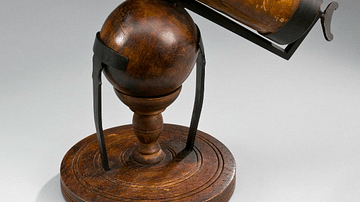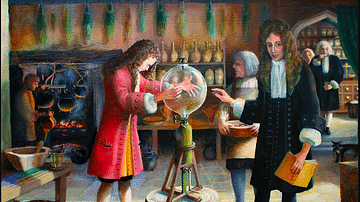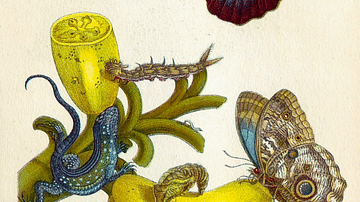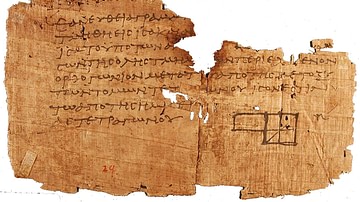The microscope was one of the most significant inventions of the Scientific Revolution, opening up completely new and miniaturised worlds. The first microscopes were invented in the first quarter of the 17th century in the Netherlands, but soon scientists across Europe were using the instrument to make new and often bewildering discoveries in the fields of botany, entomology, and anatomy.
The First Microscopes
The first optical microscopes appeared in the early 17th century, shortly after the invention of the telescope, which is generally credited to the Flemish spectacle-maker by Hans Lippershey (c. 1570 to c. 1619). A year or two later, Galileo (1564-1642) made a superior telescope, with which he observed the heavens in great detail, publishing his findings in Sidereus Nuncius (The Starry Messenger) in 1610. The microscope also originated in the Netherlands, its invention is usually credited to Cornelius Drebbel (1572-1635) or Hans Janssen. Like the telescope, the microscope used two lenses set in a hollow tube. Drebbel's model followed the telescope design not of Galileo, which had a concave and a convex lens, but of Johannes Kepler (1571-1630) who used two convex lenses in his instruments. Although in this latter arrangement, the image was inverted, it was also much clearer.
Soon there were specialist makers of microscopes, one highly respected manufacturer was John Marshall. A Marshall-designed compound microscope, which has three lenses (eyepiece, field lens, and objective lens) and the possibility to add extra light using a candle under the base, can be seen today in the Science Museum in London. One notable private maker was Antonie van Leeuwenhoek (see more below), who made over 500 microscopes, including examples that had an impressive magnification of 270 using a tiny glass bead instead of a larger glass lens. Further adaptations to improve the instrument were made, such as adding a small mirror to the base whose angle could be adjusted to direct more light to the specimen under view. The instrument maker Edward Culpeper (1670-1737) made this mirror concave, increasing the light made available in his microscopes. It was not enough to have an excellent instrument, though, preparing specimens for viewing was a skill in itself and could make the difference between gaining a new scientific discovery or seeing nothing at all.

Scientists soon put the new device to good use and began to investigate what had previously been indistinct or invisible to the naked eye. Anatomists, entomologists, and botanists were particularly keen to use this new invention to further their understanding of the natural world. In 1625, for example, Francesco Stelluti examined in detail the bodies of bees and published his research as The Apiarium, the first study based on microscopic science. Many other discoveries and academic papers soon followed, and by the second half of the 17th century, beautifully illustrated works were being published to reveal to interested readers exactly what could be seen through the latest microscopes. It now became clear that a tiny insect could be just as complex in its structure as a large mammal. The view through a microscope also raised some perplexing questions, such as if a parasitic flea itself has fleas, might not these fleas also have fleas and so on ad infinitum? The microscope had revealed new worlds, but where did they end? The invention seemed to pose more questions than the current technology could answer.
Discoveries of the Early Microscopists
There were several key figures in the early history of the microscope. Marcello Malpighi (1628-1694) was a medical man of some repute. He rose to become the Professor of Medicine at the University of Pisa and then the University of Bologna before taking up a position as the physician of Pope Innocent XII (in office 1691-1700). Malpighi was the first to use the microscope for detailed anatomical studies, and he published his On the Lungs in 1661 where he revealed their true structure. Further, Malpighi discovered that capillaries connected the veins and arteries and so confirmed William Harvey's discovery of blood circulation in the human body. Malpighi made several other in-depth studies, notably on the human brain, tongue, kidneys, and skin, as well as on the silkworm and the chicken embryo (thus essentially founding the science of embryology). Malpighi's research on human anatomy was incorporated into the influential Anatomy of the Human Body by Govard Bidloo (1649-1713), published in 1685.
Christiaan Huygens (1629-1695) was noted for his work in many other fields of science, but he also took an active interest in microscopes, manufacturing high-quality instruments with his brother Constantijn. A Dutchman, Huygens benefitted from the local manufacture of high-quality lenses.
Antonie van Leeuwenhoek (1632-1723), also from the Netherlands, made some of the most significant contributions to the growing field of microscopy. His "contributions include the discovery of red blood cells, of the circulation of blood through the capillaries, of the existence of protozoa, and of the nature of the male sperm cells" (Burns, 166). He also developed a scale of measurement by which one could compare views of different specimens. The more unusual sights van Leeuwenhoek saw in his microscopes, which used single glass beads of incredible magnification, were often recorded in drawings made by local draughtsmen. The Dutchman's work become so well known that he was able to offer his house in Delft as a sort of open museum where the public could visit and see prepared slides in the many microscopes he had set up.
Robert Hooke (1635-1703) published his Micrographia in 1665, a seminal work in the field, which became popular largely thanks to its beautifully detailed illustrations. Hooke was able to obtain clear images thanks to his scotoscope, that is, "a light-condensing brine-filled globe between his lamp light-source and his specimen" which "narrowly focussed the lamp's intensified beams by means of a convex lens" (Jardine, 44). Micrographia contains the first use of the word 'cell' in reference to biology, in this case, it is used to describe the structure of cork seen under a microscope. A new world was revealed, one that was not at all the same as the one seen with the naked eye. Hooke, for example, demonstrated that what seemed to the eye to be the sharp, single point of a needle was, when seen under a microscope, actually a ragged end of metal. Hooke, a fellow of the Royal Society, was also responsible for several technical developments in the microscope.
Jan Swammerdam (1637-1680) was an entomologist who combined his long experience at dissection with the new possibilities offered by the microscope. Swammerdam particularly focused his lenses on insect reproduction and published his General History of Insects in 1669. Swammerdam discovered that caterpillars contained what became the wings of the butterfly after metamorphosis.

Nehemiah Grew (1641-1712) was the founder of plant anatomy based on microscopy; two notable works were The Anatomy of Vegetables Begun (1672) and The Anatomy of Plants (1682). Made the Royal Society's curator of plants in 1672, Grew was the first to undertake an in-depth study of the sexual organs of plants.
The Reception of the Microscope
Many scientists heralded the arrival of the microscope but so, too, did other intellectuals. Mechanical philosophers of the 17th century, René Descartes (1596-1650) being the most famous, believed that by investigating matter and motion the world around us can be better understood. The microscope seemed heaven-sent to aid the understanding of nature's minute mechanics. However, the reception of the microscope was not always so positive.
The Christian Church was not necessarily against the discoveries of the microscope – the very first paper on microscopy by Stelluti was, significantly, dedicated to Pope Urban VIII (in office 1623-1644). For one thing, the new instrument revealed the incredible detail and ingeniousness of life on Earth; in this respect, one could, if that were one's belief, only increase one's admiration for God's work. It was suggested by some theologians that a close study of nature might be as revealing as reading the Bible. In addition, a mechanical explanation of nature did not mean divine acts like miracles could not occur (modern miracles were a belief widely held by Catholics if not Protestants). Thirdly, a focus on real-world mechanics reduced the appeal of magic and superstition, traditional enemies of the Church. There remained some serious differences between mechanical philosophy and Christian beliefs, notably the idea of transubstantiation – when a priest transforms bread and wine into the body and blood of Jesus Christ during a Catholic Mass. Many Protestants had a problem with mechanical philosophy, too, since it diminished the active role of God in worldly affairs. Even if one believed in God, the idea that the world was some sort of mechanical device which essentially ran itself was troubling to many, and such a belief led to accusations of atheism (which at the time meant denying God's supervision rather than denying the existence of God).
Some proponents of natural philosophy were concerned about the impact of the microscope (as they were with the telescope and the Scientific Revolution). There was a debate as to whether these new instruments could be trusted, and whether what they revealed was not mere trickery. Some argued that evidence from such instruments, even if they required the human eye, was not the same as evidence gained from directly using the senses. Others argued that the microscope was showing humanity what should not be seen since God had given us perfectly good eyes to view the world and to pry deeper was not humanity's place and was considered somehow impious.
Legacy
Microscopy suffered a decline in the 18th century. The microscope, for example, was not an instrument widely used in medicine. The historian J. Henry explains why this was so:
At least part of the reason for the failure of the microscope to become as essential to anatomical studies as the telescope became in astronomical studies was its inability to command authority among medical practitioners. The telescope's ability to increase the accuracy of positional astronomy guaranteed its usefulness, but knowledge of the invisible structure of organs did nothing to improve the efficacy of a medical system based essentially on the study and treatment of symptoms of disease…leading physicians like Thomas Sydenham (1624-89) and John Locke (1632-1704) explicitly rejected its use. (46)
In short, the telescope was used to prove existing theories wrong, while the microscope merely revealed a whole new set of theories now had to be created. In this sense, according to some historians, the microscope was not an essential part of the Scientific Revolution, which was a revolution against prevailing ideas, often ones which had held sway since antiquity. However, this is not entirely true. Microscopists were able to challenge quite a number of prevailing beliefs, albeit hardly ones that would bring the entire edifice of Western thought crashing down if they were revised. It had, for example, long been thought that very small insects were created spontaneously from some sort of unseen matter. The microscope revealed that tiny insects did, in fact, go through a reproductive cycle like larger creatures. The microscope, perhaps aptly given its purpose, was able to make small gains in our knowledge of the world. Really, its problem was one of technical deficiencies of lenses, lights, and slide preparation; when these were finally resolved, the instrument would come into its own.
There was one crucial area which the microscope contributed to just as much as the telescope during the Scientific Revolution, and this was the idea of scale. For millennia, the scale of our world was taken as being somehow related to that of the human body, hence the early measuring systems using fingers, hands and feet. Telescopes at one end of the scale and microscopes at the other revealed that a whole new system of measurement was required for the human mind to grasp, compare, and contrast the wonders of the visible universe from a huge distant planet right down to the minute hairs on a flea.
The microscope may not have dominated early science as it might have done, but the instrument did become popular in the homes of the wealthy. It became a sort of sophisticated toy to impress visitors with along with one's family paintings and cabinet of curiosities. Although cheaper than a telescope, a microscope was still an expensive hobby item. In the early 18th century, a typical microscope cost around £5 (at the time, equivalent to three month's wages for a labourer). Samuel Pepys (1633-1703), the famous diarist, was inspired by Hooke's Micrographia, which he described as "the most ingenious book" (Jardine, 42), to lash out £5 and 10 shillings on a microscope for his study. Unfortunately, like almost everyone else, Pepys had great difficulty seeing anything at all clearly through his microscope.
Better and much more powerful microscopes did eventually revive the scientific use of the instrument. Isaac Newton predicted "that instruments magnifying three or four thousand times might bring atoms into view" (Gleick, 94). Other thinkers of the 17th century hoped that microscopes might one day show the particles of the air and the actual movement of light. The microscope returned to the forefront of science in the 19th century with the work of such figures as Louis Pasteur (1822-1895), whose pioneering study of microbes led to vital progress in disease control and vaccinations. When more powerful microscopes were invented such as the electron microscope in the 1930s, the instrument had already taken its rightful place as one of the essential instruments of modern scientific inquiry.









